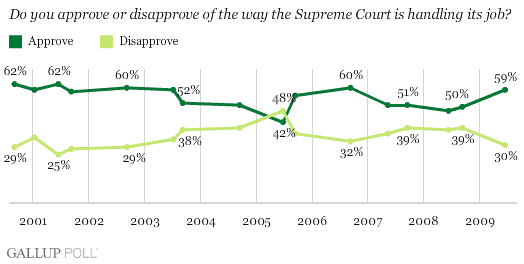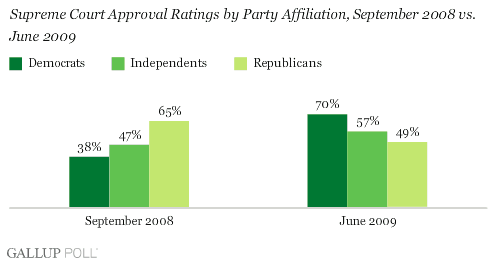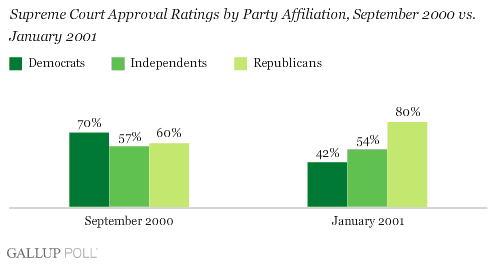PRINCETON, NJ -- The latest Gallup Poll finds 59% of Americans approving of the job the U.S. Supreme Court is doing, a significant improvement from ratings near 50% for the past two years, and just below the high of 62% measured in September 2000 and June 2001.

The overall number, though higher, masks considerable change in views of the Supreme Court by party since last fall. The new June 14-17 poll finds 70% of Democrats approving of the job the Supreme Court is doing, much higher than the 57% of independents and 49% of Republicans who approve. Last fall -- during the final months of the Bush administration -- the party ratings were nearly the reverse, with Republicans giving the court much higher marks than Democrats.

Given the timing of the September 2008 and June 2009 polls, it is unclear what impact President Obama's nomination of Judge Sonia Sotomayor to the Supreme Court has had on Republicans' and Democrats' views of the court. The dramatic party shift may simply reflect a phenomenon Gallup has observed in the past coinciding with changes in presidential administrations, with supporters of the new president's party turning much more positive about government institutions and conditions in the country more generally, and supporters of the outgoing president taking a dimmer view of both.
Gallup found a change in party ratings of the Supreme Court during the Clinton-Bush transition between 2000 and 2001. That change was greatly aided, however, by the court's decision in Bush v. Gore, which effectively awarded the disputed 2000 presidential election to Bush.

To cite a more recent example, Democrats' and Republicans' views of Federal Reserve Chairman Ben Bernanke (a Bush appointee) flipped this year, now that Bernanke is serving under a Democratic president.
But the improved overall ratings of the Supreme Court probably also reflect a more positive view of government in general, given the change in administrations from George W. Bush's to Barack Obama's -- particularly because none of the Supreme Court's rulings thus far in the 2008-2009 term has been particularly controversial. Gallup has documented a similar increase in ratings of Congress, and Obama has enjoyed relatively high approval ratings throughout his term.
Even taking into account the party switch in ratings of the Supreme Court, all major party groups show higher ratings than those of the comparable groups last fall. Specifically, approval ratings of the court among supporters of the president's party (Republicans last fall; Democrats currently) are higher now (70%) than in September (65%). Supreme Court approval by the party out of the White House (Democrats last fall; Republicans currently) has also improved -- from 38% to 49%. And independents have shown a 10 percentage-point increase in approval over the last nine months.
The latest poll comes just before the close of the Supreme Court's 2008-2009 term, and would not reflect the impact of any yet-to-be-announced high-profile decisions. One highly anticipated decision involves the affirmative action case brought by New Haven, Conn., firefighters. In this ruling, the high court could potentially reverse an appeals court decision made in part by Sotomayor.
Survey Methods
Results are based on telephone interviews with 1,011 national adults, aged 18 and older, conducted June 14-17, 2009. For results based on the total sample of national adults, one can say with 95% confidence that the maximum margin of sampling error is ±3 percentage points.
Interviews are conducted with respondents on land-line telephones (for respondents with a land-line telephone) and cellular phones (for respondents who are cell-phone only).
In addition to sampling error, question wording and practical difficulties in conducting surveys can introduce error or bias into the findings of public opinion polls.
